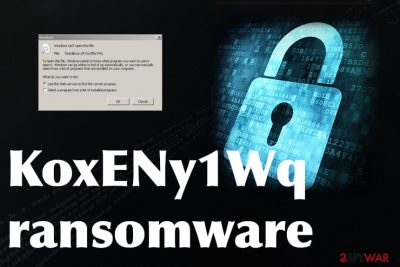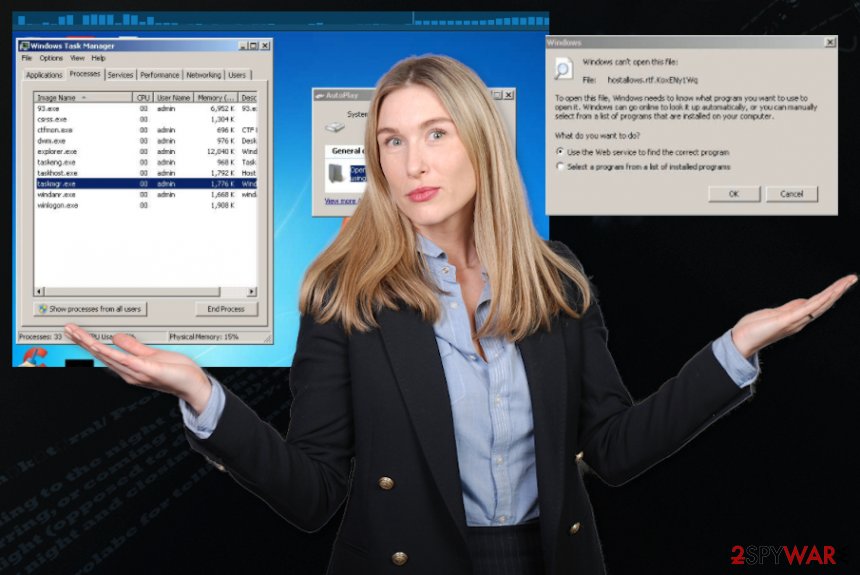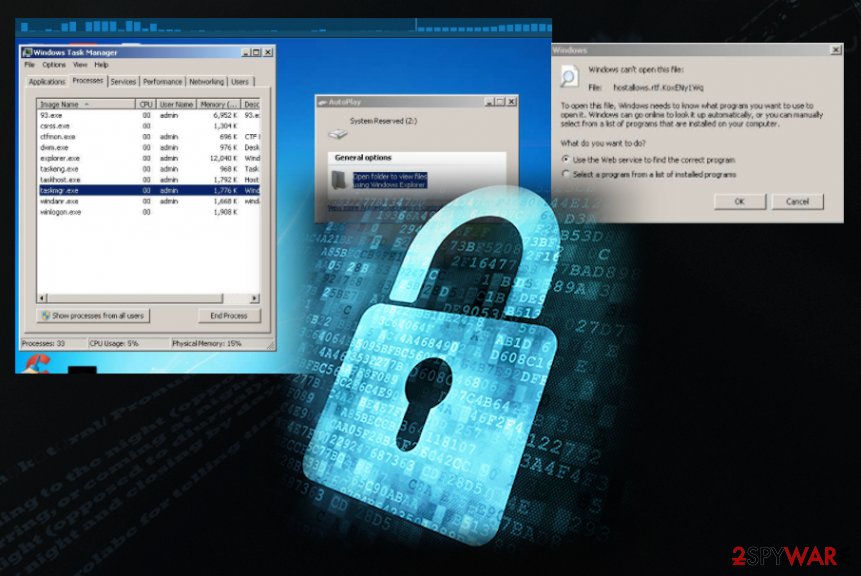KoxENy1Wq ransomware (Virus Removal Instructions) - Decryption Methods Included
KoxENy1Wq virus Removal Guide
What is KoxENy1Wq ransomware?
KoxENy1Wq ransomware – the cryptovirus that demands money after the file encryption

Even though it is new and not analyzed in-depth yet, KoxENy1Wq ransomware virus is powerful and can get extremely dangerous. You shouldn't wait for any ransom demands or additional messages from these criminals behind the cryptovirus. In most cases, these malicious actors focus on getting money from people, so the encryption is the first process that is launched, but system folders and functions get significantly affected too.
| Name | .KoxENy1Wq virus |
|---|---|
| Type | Ransomware |
| The file marker | .KoxENy1Wq is the extension that appears at the end of every file affected by the encryption procedure. It comes right after the original name and the filetype determining appendix |
| Symptoms | The infection starts in the background, so the performance speed may get affected. Other processes appear running in the Task Manager, files get locked and marked using the mentioned randomized extension |
| Distribution | Typically such threats spread using malicious files and techniques that allow them to inject code on the system directly. Dangerous files can be added in the package with pirated software, attached to the spam email or get downloaded from a hacked/malicious site |
| Possible features | Generally, ransomware should deliver the ransom note file with the message from criminals, list all the details and the ransom amount, contact info there. Sometimes these threats also load trojans, worms, other threats to gather valuable information from the system[2] |
| Elimination | KoxENy1Wq ransomware removal process requires professional anti-malware tools because there are other files and programs that need to get deleted. Manual termination is pretty much impossible |
| Repair | When the computer is affected by such a threat, various parts of the system get altered, and you may not notice that. Running a check with FortectIntego or a different optimizer could find and fix the affected or corrupted data for you |
KoxENy1Wq ransomware is the virus that encrypts files like audio, video, pictures, archives, or even backups. It affects any found data on the system and can compromise the machine in general significantly. These files get affected when encryption algorithms provide the opportunity to change the original code of the file.
Attackers mainly focus on getting money from people, so these encryption processes end up with a ransom demand by KoxENy1Wq ransomware creators. It is not known, but you should receive the text file with a particular extortion message or the HTML window with further instructions.
Unfortunately, we don't have a particular message that KoxENy1Wq ransomware developers send to victims, but there is no reason to pay these criminals nor to think about contacting them. The best option for such infection is to clear all traces of the virus and replace affected parts using your safe files from a backup.[3]

Besides the fact that this is the file-locking threat, KoxENy1Wq ransomware affects system files differently – the more crucial and dangerous way. It focuses on deleting system files, disabling some functions, security features, programs. It can delete files needed for the data recovery or terminate functions helping to clear the malware.
These functions need proper repair after the KoxENy1Wq ransomware removal. Or even before that, so you can use the anti-malware engine properly. Rebooting the system in Safe Mode with Networking can help to disable the virus and run the proper system scan using the chosen AV.
You need to remove KoxENy1Wq ransomware properly and focus on data recovery. Unfortunately, that is easier said than done because threats like this can damage system files and functions too. You may experience huge losses when you decide to pay since after such cryptocurrency transfers criminals tend to disappear with the promised decryption tool.
Make sure to clear the damage that KoxENy1Wq ransomware virus caused before you add any external device on the computer or recover files using automatic methods. Decryption tool is not developed for this threat, you have fewer options, but some of them are listed below the article. Be careful and double-check before adding new files on the machine.

Ransomware payload injecting methods
The threat can distribute the malicious code via files spread on social media, hacked or malicious sites. Even fake software installers, updates found on the internet can trigger drops of the malicious files and trojans, malware that is designed to spread ransomware files and infect machines further. It is a common method.
The more sophisticated and stealthy technique that allows cryptocurrency extortion-based malware to end up on the machine involves email notifications and attachments on them. When you receive the email stating about financial information, invoices, order details, and you see the familiar company, you may not think before opening the email.
However, such deceptive and misleading notifications include files with a malicious script that triggers the infection, encryption process. Any suspicious sender, file attachments, random shortened links in the message should be considered a red flag and encourage you to delete the email right away.
KoxENy1Wq virus termination tips and information about data recovery
The first thing that you need to know about KoxENy1Wq ransomware removal is that the threat cannot be easily found and deleted from the machine manually. You need to get proper anti-malware or security tools, so all the threats and associated programs get detected and eliminated.
You can remove KoxENy1Wq ransomware with tools like SpyHunter 5Combo Cleaner or Malwarebytes, but you need to choose the AV engine that can find the threats. Not all of them do so due to differences in databases of malware that are used. When you tried a few programs, and the issue is found, you only need to clean the machine by following the suggestions.
Remember that KoxENy1Wq ransomware virus changes things in system folders too, so you need to clear them before you go for any data recovery options. Rely on FortectIntego and fix the affected data, corrupted system files, program functions. Then you can try to restore encoded files when the system is virus-free. Rely on your file backups for that or third-party programs that can restore data for you.
Getting rid of KoxENy1Wq virus. Follow these steps
Manual removal using Safe Mode
Reboot the system in Safe Mode with Networking to have a better chance to remove KoxENy1Wq ransomware
Important! →
Manual removal guide might be too complicated for regular computer users. It requires advanced IT knowledge to be performed correctly (if vital system files are removed or damaged, it might result in full Windows compromise), and it also might take hours to complete. Therefore, we highly advise using the automatic method provided above instead.
Step 1. Access Safe Mode with Networking
Manual malware removal should be best performed in the Safe Mode environment.
Windows 7 / Vista / XP
- Click Start > Shutdown > Restart > OK.
- When your computer becomes active, start pressing F8 button (if that does not work, try F2, F12, Del, etc. – it all depends on your motherboard model) multiple times until you see the Advanced Boot Options window.
- Select Safe Mode with Networking from the list.

Windows 10 / Windows 8
- Right-click on Start button and select Settings.

- Scroll down to pick Update & Security.

- On the left side of the window, pick Recovery.
- Now scroll down to find Advanced Startup section.
- Click Restart now.

- Select Troubleshoot.

- Go to Advanced options.

- Select Startup Settings.

- Press Restart.
- Now press 5 or click 5) Enable Safe Mode with Networking.

Step 2. Shut down suspicious processes
Windows Task Manager is a useful tool that shows all the processes running in the background. If malware is running a process, you need to shut it down:
- Press Ctrl + Shift + Esc on your keyboard to open Windows Task Manager.
- Click on More details.

- Scroll down to Background processes section, and look for anything suspicious.
- Right-click and select Open file location.

- Go back to the process, right-click and pick End Task.

- Delete the contents of the malicious folder.
Step 3. Check program Startup
- Press Ctrl + Shift + Esc on your keyboard to open Windows Task Manager.
- Go to Startup tab.
- Right-click on the suspicious program and pick Disable.

Step 4. Delete virus files
Malware-related files can be found in various places within your computer. Here are instructions that could help you find them:
- Type in Disk Cleanup in Windows search and press Enter.

- Select the drive you want to clean (C: is your main drive by default and is likely to be the one that has malicious files in).
- Scroll through the Files to delete list and select the following:
Temporary Internet Files
Downloads
Recycle Bin
Temporary files - Pick Clean up system files.

- You can also look for other malicious files hidden in the following folders (type these entries in Windows Search and press Enter):
%AppData%
%LocalAppData%
%ProgramData%
%WinDir%
After you are finished, reboot the PC in normal mode.
Remove KoxENy1Wq using System Restore
You should rely on System Restore feature that can recover the machine to a previous state for you
-
Step 1: Reboot your computer to Safe Mode with Command Prompt
Windows 7 / Vista / XP- Click Start → Shutdown → Restart → OK.
- When your computer becomes active, start pressing F8 multiple times until you see the Advanced Boot Options window.
-
Select Command Prompt from the list

Windows 10 / Windows 8- Press the Power button at the Windows login screen. Now press and hold Shift, which is on your keyboard, and click Restart..
- Now select Troubleshoot → Advanced options → Startup Settings and finally press Restart.
-
Once your computer becomes active, select Enable Safe Mode with Command Prompt in Startup Settings window.

-
Step 2: Restore your system files and settings
-
Once the Command Prompt window shows up, enter cd restore and click Enter.

-
Now type rstrui.exe and press Enter again..

-
When a new window shows up, click Next and select your restore point that is prior the infiltration of KoxENy1Wq. After doing that, click Next.


-
Now click Yes to start system restore.

-
Once the Command Prompt window shows up, enter cd restore and click Enter.
Bonus: Recover your data
Guide which is presented above is supposed to help you remove KoxENy1Wq from your computer. To recover your encrypted files, we recommend using a detailed guide prepared by 2-spyware.com security experts.If your files are encrypted by KoxENy1Wq, you can use several methods to restore them:
Data Recovery Pro is the possible method for recovering encoded material
You can use this program for encrypted or accidentally deleted files
- Download Data Recovery Pro;
- Follow the steps of Data Recovery Setup and install the program on your computer;
- Launch it and scan your computer for files encrypted by KoxENy1Wq ransomware;
- Restore them.
Windows Previous Versions feature helps with data damaged by KoxENy1Wq ransomware virus
When you enable the System Restore feature, you can try this method for file restoring purpose
- Find an encrypted file you need to restore and right-click on it;
- Select “Properties” and go to “Previous versions” tab;
- Here, check each of available copies of the file in “Folder versions”. You should select the version you want to recover and click “Restore”.
ShadowExplorer is the file recovery feature that OS can offer you
When KoxENy1Wq ransomware is not affecting Shadow Volume Copies, you can rely on the ShadowExplorer for the proper recovery
- Download Shadow Explorer (http://shadowexplorer.com/);
- Follow a Shadow Explorer Setup Wizard and install this application on your computer;
- Launch the program and go through the drop down menu on the top left corner to select the disk of your encrypted data. Check what folders are there;
- Right-click on the folder you want to restore and select “Export”. You can also select where you want it to be stored.
There are no available decryption tools
Finally, you should always think about the protection of crypto-ransomwares. In order to protect your computer from KoxENy1Wq and other ransomwares, use a reputable anti-spyware, such as FortectIntego, SpyHunter 5Combo Cleaner or Malwarebytes
How to prevent from getting ransomware
Stream videos without limitations, no matter where you are
There are multiple parties that could find out almost anything about you by checking your online activity. While this is highly unlikely, advertisers and tech companies are constantly tracking you online. The first step to privacy should be a secure browser that focuses on tracker reduction to a minimum.
Even if you employ a secure browser, you will not be able to access websites that are restricted due to local government laws or other reasons. In other words, you may not be able to stream Disney+ or US-based Netflix in some countries. To bypass these restrictions, you can employ a powerful Private Internet Access VPN, which provides dedicated servers for torrenting and streaming, not slowing you down in the process.
Data backups are important – recover your lost files
Ransomware is one of the biggest threats to personal data. Once it is executed on a machine, it launches a sophisticated encryption algorithm that locks all your files, although it does not destroy them. The most common misconception is that anti-malware software can return files to their previous states. This is not true, however, and data remains locked after the malicious payload is deleted.
While regular data backups are the only secure method to recover your files after a ransomware attack, tools such as Data Recovery Pro can also be effective and restore at least some of your lost data.
- ^ #Ransomware Ext: .KoxENy1Wq. Twitter. Social media.
- ^ Tara Seals. REvil Ransomware Gang Adds Auction Feature for Stolen Data. Threatpost. Security and malware news.
- ^ Casey Morgan. Top Five Reasons Why You Need to Backup Your Data. Storagecraft. Recovery zone.





















